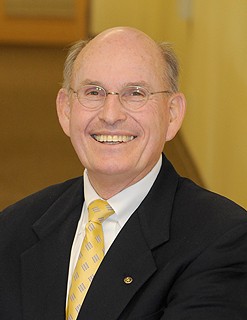
Cuesta College President Gil Stork. The community college in San Luis Obispo has struggled for years with accreditation but Storke said a turnaround is imminent. (courtesy photo)
Eight months after San Luis Obispo County’s Cuesta College received its second negative report card from a regional accreditation agency, officials say the school is on track to reaffirm its accreditation.
In an interview with the Business Times, Cuesta President Gil Stork said the school is working hard to address its accreditation problems, which have become dire since a February report said the school would be in danger of closing if it didn’t improve its educational and administrative standards.
Losing accreditation would mean losing state funding. It also means students at the unaccredited campus would no longer be eligible to receive financial aid or transfer credits to four-year state universities such as Cal Poly San Luis Obispo.
“I’m confident that we’ve moved in the right direction and we’ve made tremendous progress. We have a new dynamic in terms of getting things done,” Stork said. “But it’s not resolved yet. We’re in the process of developing a response to the complaints the commission issued in February.”
Cuesta has been under fire since 2009, when the Accrediting Commission for Community and Junior Colleges Western Association of Schools and Colleges placed it on probation, pointing out nine specific areas where the school needed to improve. When the commission paid Cuesta a follow-up visit in November 2011, it said the school failed to meet the requirements necessary to remove it from probation — although the college had shown improvement in some areas, three of the nine problem areas were still under scrutiny. On Feb. 3, the agency sent a letter to the college directing it to show why accreditation should not be withdrawn.
In the letter, which Stork called a “serious but temporary setback” at the time, the agency warned that the college would lose accreditation if it didn’t improve in three areas: planning and assessment, technology resources and financial planning and stability.
As of February, 37 percent of the state’s community colleges — including five of the six institutions in the Tri-Counties — were facing disciplinary action. Although just one two-year college has been stripped of its accreditation, schools have started taking the accreditation commission’s recommendations more seriously in recent years.
“There are systematic changes coming down the pike in the way the state’s community colleges are run. The greatest is that the accreditation committee has more teeth that it used to,” Stephen Blum, board chairman for the Ventura County Community College District, told the Business Times in February. “Colleges have been slow to realize that, so they’ve been slow to take the commission as seriously as they should.”
The commission is set to review Cuesta’s case in November, one year after the visit that led to the show-cause letter. Stork said that he and other top officials have cracked down since being put on notice and are creating fiscal and academic plans they hope will eventually lead the college through its accreditation troubles. But because the new standards won’t have been in place for a full year before the commission’s November visit, Stork said the college might retain its current status for another year, even if the agency approves of the changes.
“Even though we’ve done a lot of work and had good advice from the commission’s office, it may not be able to fully reaffirm our accreditation until we can say that a cycle has worked,” Stork said. “They may keep us on ‘show cause’ until a cycle is completed. But even if we’re kept there, that will be a victory.”
Stork, who was appointed Cuesta’s interim president in January 2011 and has since become the campus’ permanent leader, said the college has done the “grunt work” of preparing the plans that will be instituted when the fall semester begins in mid-August. Of the three areas that were found to need improvement, Stork said the college has made significant progress on two of them, planning and assessment and technology resources. He said the commission has since retracted its statement on the third, financial planning and stability, because the college is “doing quite well in that area.”
For the planning element, the college has developed 10 long-range documents, including a facilities plan, a master plan and a strategic plan. Together, they read like a “roadmap to improve student achievement,” according to Stork. Now, the school is writing a show-cause report that will be presented to the accrediting commission in September, in advance of a board meeting scheduled for Oct. 3.
Stork said the school has also made specific changes in the way it operates. For instance, Stork removed the person who was previously in charge of accreditation duties and replaced her with someone new. Cathleen Greiner, who was the college’s vice president of academic affairs, was removed from her post in February due to performance issues. Deboarh Wulff, dean of academic affairs, is now filling Greiner’s post.
“When we got the notification back in February, we saw that whatever we were doing wasn’t working,” Stork said. “So we made a pivotal move to change leadership, and she’s done a fantastic job. Before, we were caught in a spin cycle. We weren’t addressing the basic elements of what the commission was looking for.”
Cuesta, with enrollment of about 9,200, is a feeder school for nearby Cal Poly, the top university in the California State University System. Many students get their general education requirements out of the way at the two-year college before transferring to the university for a four-year degree.






 Print
Print Email
Email
















